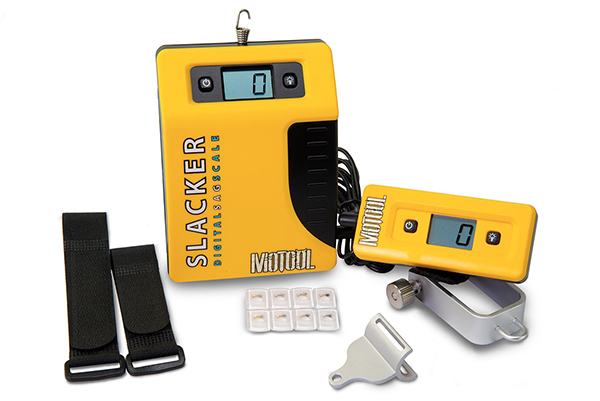AMERICAN MOTORCYCLIST July 2019
Member Tested: Motool Slacker

MSRP: Base model, $159.99; Adventure bundle, $179.99
Info: www.motool.co
Commitment to bike maintenance and setup are a personal choice. Some of us follow manufacturer’s schedules like clockwork. Others treat these recommendations as informed suggestions.
Often, simply having a better tool can make all the difference.
The folks at Motool want the Slacker to be that tool for setting suspension sag—the go-to device for dialing in the right amount of preload on your bike’s springs.
Manufacturers spend enormous amounts of money engineering, testing and building the complex parts of your bike’s suspension. Sag is an important part of the equation. You don’t want to dampen all that engineering effort by passing up this simple setting.
Sag is also a tuning element, impacting both suspension performance and handling. What’s best for one rider on one surface might not work for another in a different environment.
Setting sag isn’t complicated (see box), but a lot of riders skip it for the simple reason that using basic tools (that is, a tape measure) makes it a two-person job.
The Slacker is one answer to this problem. It’s a digital device that measures sag using a retractable cord. Attach the magnet-mounted device to your bike’s axle. Stretch the cord to the designated point on your rear fender, and then capture the unladen distance and store it in the Slacker.
Now, you can sit on the bike to capture your sag value. This can be read off a secondary digital readout mounted on the bike’s handlebars. You then can adjust your sag accordingly.
An optional kit for adventure bikes includes different mounting options for the cord and as well as a fork adapter to measure fork sag (useful if your bike allows you to adjust fork preload).
The Slacker is easy to use and significantly speeds up and simplifies the process of setting your sag. Whether the price is worth it depends on how committed you are to proper bike setup, how often you change out your luggage or whether you ride both with and without a passenger.—AMA Staff
Setting Sag 101
Achieving the correct suspension sag is straightforward. The rate of your suspension spring (almost always a metal coil, but sometimes an air bladder) and the amount of preload on that spring determines your sag.
First, measure the distance from your rear axle to a point above on your frame, fender or seat when the rear wheel is off the ground.
Then, measure between those two points with the wheel back on the ground and you sitting on the bike normally (fully geared up).
The difference between these two distances is your laden sag.
Compare the difference to manufacturer specs. If it’s too much, you increase the preload on the spring. If it’s too little, you decrease the preload on the spring.
With the laden sag set, the static sag value is how much your bike droops with the rear wheel on the ground and you off the bike.
If your static sag is less than its spec, then you’ve preloaded the spring too much to accommodate your weight. You need a heavier spring. Similarly, if your static sag is more than its spec, you need a lighter spring.
